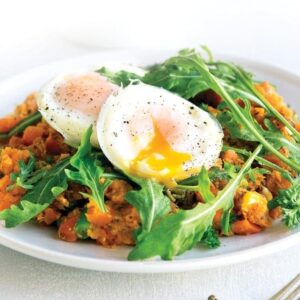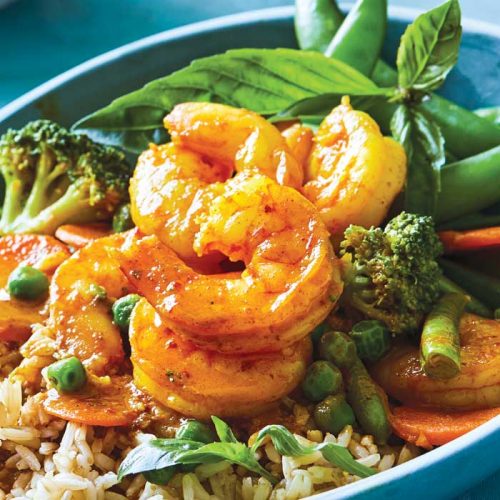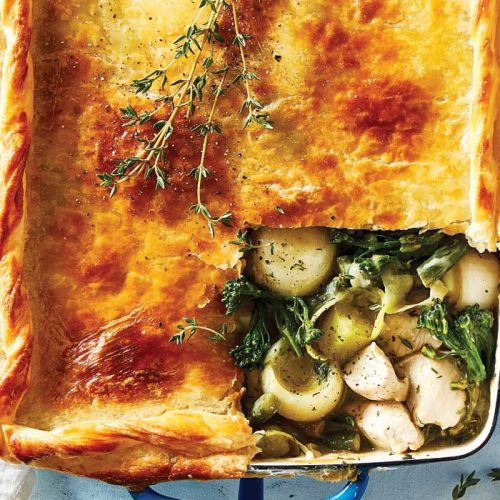
Insulin is a hormone that helps your body turn food into fuel, but sometimes the process isn’t so smooth. In this complete guide, dietitian Melissa Meier looks at the science around insulin resistance, who it affects, whether it’s reversible and what can be done to tackle it.
You’ve been eating the right foods and exercising daily, but the scales somehow just won’t budge. You know something isn’t quite right, but you can’t put your finger on it. What’s the catch? It could be a condition called insulin resistance.
Roughly one in four people have some degree of insulin resistance, which is a precursor to type 2 diabetes — but because it’s a ‘silent’ condition, you might not even know you have it.
A lot of misconceptions still surround insulin resistance, such as: Is it really that serious? Is it reversible? Do I need to give up carbs?
To set the record straight, we scrutinise some of the most popular myths about insulin resistance — and share the latest science.
What is insulin resistance?
When you eat carbohydrate-rich foods like bread, potatoes or fruit, your body breaks the carbs down into sugar, or glucose, which enters your bloodstream. Your pancreas then releases the hormone insulin, which acts as a key to open the door for glucose to enter your body’s cells. Once inside, glucose can be used immediately for energy, or stored in the muscles and liver as glycogen to be used later. If glycogen stores are at full capacity, excess glucose is stored as fat.
If you have insulin resistance, however, insulin isn’t as effective — think of the ‘door’ as jammed and rusty, so to speak, making it hard for your body to clear the glucose from your bloodstream. Essentially, this means that your muscles and liver resist the action of insulin and find it hard to take up glucose, so your body needs to work harder to produce more insulin, even though it is dealing with the same volume of glucose.
Over time, this results in high blood glucose levels as well as high insulin levels, and, if the condition is left untreated, it can lead to type 2 diabetes.
The path to type 2 diabetes
1 Insulin resistance
This occurs when the body’s normal response to insulin starts to weaken, leading the body to produce more insulin in order to maintain normal blood sugar levels. At this stage, healthy lifestyle changes can often improve or reverse insulin resistance.
2 Pre-diabetes
By now, the body starts to struggle to make the extra insulin it needs to overcome insulin resistance.
When a person has pre-diabetes blood glucose levels begin to rise above the normal range, so that the risk of acquiring type 2 diabetes within 10 years increases.
3 Type 2 diabetes
Insulin resistance worsens, insulin production declines and blood glucose levels climb even higher, resulting in type 2 diabetes. If type 2 is left untreated, damage to nerves and cells can occur, leading to serious health complications.
Common questions about insulin resistance answered
Q How do I know if I have insulin resistance?
A You could have insulin resistance and not realise it, because it often has few signs or symptoms. Extra weight, particularly around your midriff, is one sign. Others are rather ambiguous, like relentless fatigue, bloating and sugar cravings.
To be diagnosed with insulin resistance, your doctor will send you for a series of blood tests. “The gold standard is a glucose tolerance test with insulin levels,” says leading Australian dietitian Susie Burrell. “This test assesses at baseline, 1 and 2 hours what insulin is doing in response to a carbohydrate load.”
Q Is insulin resistance reversible?
A The good news is you can increase your sensitivity to insulin, or reverse insulin resistance altogether, through eating and lifestyle changes.
“It requires aggressive diet and exercise to reverse it, but it’s not impossible,” says Burrell. “It really depends on how long the person has had insulin resistance, their weight and genetics.
“High-intensity interval training (HIIT) is ultra-beneficial, regardless of other lifestyle changes. HIITs effects are fast, because they help to stimulate the muscle cells to take up glucose instantly.
“Getting enough sleep and managing stress can also improve how insulin works in your body,” adds Dr Kate Marsh, an Advanced Accredited Practising Dietitian.
Q I can’t seem to shift belly fat. Is insulin resistance to blame?
A Insulin resistance could be the reason behind stubborn belly fat, due to high levels of insulin circulating in your body. “Insulin promotes storage of fat and inhibits fat burning,” says Marsh. “While this is important when your body wants to store energy for later use, having too much insulin can make it easier to gain weight and harder to lose it.”
Insulin resistance isn’t the only cause of belly fat, however, so other medical issues shouldn’t be ruled out. “Belly fat can be related to a number of other hormonal conditions. It could also be due to a high alcohol intake or liver dysfunction, or simply genetics,” explains Burrell.
Q Does insulin resistance lead to diabetes, and is it dangerous?
A If untreated, insulin resistance can lead to type 2 diabetes. Insulin resistance precedes type 2 diabetes by 10 years or so, but identifying it early and managing it with diet, exercise and medication can help prevent type 2 diabetes.
When your body cannot keep up with elevated insulin production, your blood sugar levels stay elevated above the healthy range — but at this stage, they aren’t high enough for you to be diagnosed with diabetes. This condition is called ‘pre-diabetes’, and there are two types: impaired glucose tolerance (blood sugar levels are elevated after eating) and impaired fasting glucose (blood sugar levels are elevated when youve been fasting). If no lifestyle changes are made, pre-diabetes can lead to type 2 diabetes, damaging nerves, eyes and/or kidneys.
Q Is insulin resistance caused by eating too much sugar?
A Eating a lot of sugary foods can contribute to reduced insulin sensitivity, but consuming sugar itself is not to blame. One of the main risk factors for insulin resistance is being overweight — and, of course, eating too many sugary, high-kilojoule/calorie foods like biscuits, soft drink and lollies can contribute to weight gain.
Carrying too much weight around your mid-section (think: apple body shapes) can be especially dangerous, because it correlates with a high percentage of fat around your organs, called visceral fat. This type of fat can lead to inflammation, which is thought to play a significant role in insulin resistance.
Other insulin resistance risk factors include a family history of the condition, being physically inactive, having a certain ethnic background, or having polycystic ovarian syndrome (PCOS)
Q Do I need to stop eating carbohydrates and even fruit if I have insulin resistance?
A Of course not! People tend to believe that because carbohydrate-rich foods raise blood glucose levels, removing them completely is the best remedy, but that’s not the case.
“Someone may lose a significant amount of weight and reduce their insulin levels by cutting carbs, but this is not targeting the underlying condition … it’s simply masking the problem,” says Burrell. “In my experience, a moderate-carbohydrate diet is a much better approach. In conjunction with exercise, this ultimately improves the person’s insulin resistance over time.”
An ultra-low-carbohydrate diet, in fact, can actually leave you worse off in the long run. “There is evidence that low-carbohydrate diets, particularly those high in animal foods, can worsen insulin sensitivity and increase your risk of type 2 diabetes,” adds Marsh.
Eat to beat it!
The best diet for someone who has insulin resistance is plant-based with a low-glycemic (GI) index, that’s low in saturated fat and high in fibre. This includes:
Colourful vegetables
Rich in immunity-boosting vitamin C and gut-loving fibre, veggies are oh-so-good for you. They’re also low in kilojoules, so they play a key role in weight management. Aim to fill half your plate at every meal with a variety of different veggies
Lean protein
Tofu, legumes, seafood, eggs, poultry and meat are packed with protein to keep hunger pangs and cravings at bay. Focus on small portions of lean protein (one-quarter of your plate) at each meal, and include high-protein snacks like yoghurt.
Healthy carbohydrates
Minimally processed wholegrain foods like brown, grainy bread and rolled oats, as well as sweet potatoes, lentils and chickpeas, provide slow-burning energy to keep you feeling satisfied. A small portion at each meal is essential in any healthy diet.
Fruit
Yes, fruit contains natural sugars — but it’s wrapped up with fibre for a healthy gut, micronutrients to keep your body working at its best, plus antioxidants to fight disease. Aim for two pieces of fresh fruit a day.
Dairy or alternatives
Milk, yoghurt and cheese (or calcium-fortified alternatives such as soy milk) offer many essential nutrients, including calcium to support the growth and maintenance of strong bones and teeth.
Help! Where do I start?
If you suspect you have insulin resistance, your first port of call is your doctor. From there, you should see an Accredited Practising Dietitian (APD) for individualised nutrition advice.
Article sources and references
- Better Health Channel. 2014. Metabolic syndrome. Accessed May 2020https://www.betterhealth.vic.gov.au/health/conditionsandtreatments/metabolic-syndrome
- Centres for Disease Control and Prevention. 2019. Insulin Resistance and Diabetes. Accessed May 2020 https://www.cdc.gov/diabetes/basics/insulin-resistance.html
- Diabetes Australia. 2018. Tracking the culprits of insulin resistance. Accessed February 2020https://www.diabetesaustralia.com.au/news/tracking-the-culprits-of-insulin-resistance/
- Diabetes Australia. 2018. Pre-diabetes. Accessed February 2020https://www.diabetesaustralia.com.au/about-diabetes/pre-diabetes/
- Diabetes Queensland. 2017. What is insulin resistance? Accessed February 2020https://www.diabetesqld.org.au/news/insulin-resistance-in-type-1-diabetes/
www.healthyfood.com













